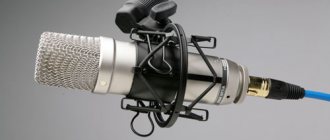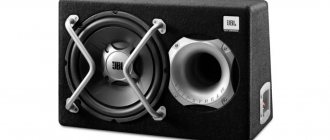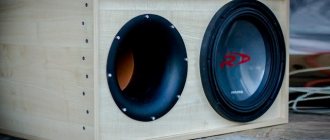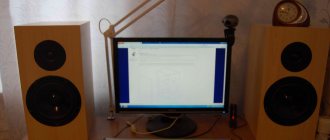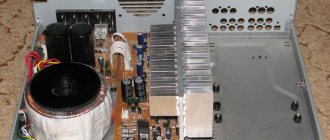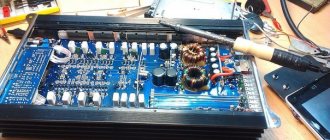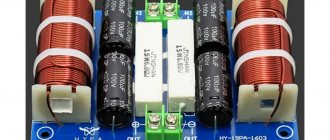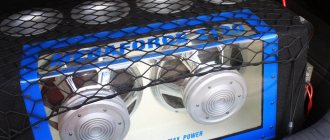In practice, there is a fairly wide variety of electrical energy converters, both in terms of design features and operating principles. Among the devices for changing the voltage, there are armored, rod and toroidal transformers. The latter option is shaped like a donut, making it the most effective in terms of magnetic flux transmission. Its efficiency can approach 100% and is quite easy to wind, so many radio amateurs try to make a toroidal transformer with their own hands.
The design and principle of operation of a sound amplifier
An audio amplifier is a set of parts installed on a board, with an input and an output, which requires an external power source to operate. The power amplifier (PA) is always located at the output, which is why it is called the terminal amplifier.
Such a device can enhance:
- frequency of sound as a whole (USF);
- low frequency (ULF);
- high frequency power (UMZCH).
Performed as part (functional block) of equipment or as an independent device.
Large antennas and loudspeakers require high gain amplifiers (tens or even hundreds of kW). It is achieved by simultaneously increasing current and voltage. These devices are either transformerless or transformer-based.
The most common tube transformer amplifiers in everyday life. In professional equipment, a transformer is used if it is necessary to smooth out the links of long wiring spread over a relatively large area.
A transformer is an amplifier in which this device is installed at the output to harmonize low frequencies and protect equipment from short circuits.
The main disadvantage of using a transformer in an audio amplifier is the increase in size and weight.
UMChZ amplifies signals containing information about sound in telemechanics, computing and measuring equipment, flaw detection. In this type of amplification equipment, in addition to the PA, a pre-amplifier with an equalizer or tone and volume control is installed. Its purpose is to bring the voltage and power to the levels necessary for the operation of the terminal PA connected to the receiver modulator, headphones, and speakers.
ULFs are built into radio broadcasting, sound recording and sound reproduction equipment, including vehicles.
The output of an audio amplifier (AU) can be one- or two-stage, operating in one of three modes:
- A (single-ended) – transistors and lamps are arranged in a linear order, ultrasonic without current limiting or oversaturation modes;
- B (push-pull) - all active elements reproduce a unipolar signal with virtually no distortion, nonlinear distortions are compensated by transistors or lamps;
- AB (push-pull) – intermediate mode between A and B;
- D – to operate in key mode by converting the input signal into PWM pulses controlled by the output switch, the sound is restored by the output LC filter.
TOT Series
This series includes three compact isolation transformers. The company itself explains that the TOT series has solutions suitable for most users who need stable, clean power for their home AV systems.
Network air conditioner Torus Power TOT AVR CE
The TOT Mini model provides current up to 3 A and can be used to work with projectors, TVs, monitors, network devices, AV signal sources and active speakers. The TOT Max model provides current up to 8 A, which is enough to work with power amplifiers and other energy-intensive consumers. As for the third model, TOT AVR (4 A), it uses the already mentioned AVR voltage regulator and has Ethernet control. This model, according to the manufacturer, is perfect for home theaters and music systems with a large number of digital components.
TOT Mini and TOT Max air conditioners are available in rack versions. The SMSS anti-surge protection module is installed to order during the production process.
Options for schematic solutions
The simplest low-frequency class amplifier consists of two identical transistors connected through an emitter (bipolar transistor) and an output transformer, the primary winding of which consists of 2 identical halves. Power from an external source is supplied to the transistors through the primary winding.
One transistor is supplied with a positive voltage, and the second with a negative voltage, which periodically changes to the opposite. The transistors operate alternately, which is why the device is called push-pull. The currents are summed to the winding, the final transformer produces lower and more powerful oscillations.
To increase power, resistors are included in the circuit to remove the bias voltage from the transistors. Current is supplied to the transformer through the halves of the secondary winding, corresponding to the halves of the primary. The high frequencies at the output are separated by a capacitor. To power such an ultrasonic device, you can use an AC power supply or batteries.
In a push-pull UMChZ there are 2 transformers: input (preliminary) and output (final), voltage is supplied to the transistors from the first. One transistor opens, the second remains closed, after some time the position changes to the opposite. Power supply requires a block of resistors, capacitors, a surge protector, and power transistors that switch voltage.
Dynamic characteristics
Torus Power devices have impressive dynamic current delivery capabilities. For example, the Torus Power isolating transformer with an operating current of 20 A has an output resistance of 0.2 Ohm and, with a sharp increase in load, is capable of delivering up to 400 A. The transformer core acts as a kind of storage device, providing additional power at the right moments. A typical amplifier with a total power of 200 W requires 10 A of current, but at its peak can draw more, up to 50 A. A regular electrical outlet is not capable of delivering 50 A of current. A 20A Torus isolation transformer plugged into the same outlet will provide the amplifier with this required current.
What kind of transformer is needed
When purchasing, renting or manufacturing an ultrasonic sound system, the required power and type of speaker system are taken into account.
It is quite difficult to determine which power is better. It all depends on personal preference. Some people need 500 watts in an apartment, others are able to sound a large hall at 200 watts. The sensitivity of the acoustics and the literacy of the specialist who will sit at the control panel are also important.
Parameters such as sound purity and equipment reliability are no less important, but they can only be determined indirectly.
When choosing, it is enough to take into account that the power of the amplifier must be higher than the power of the speaker system. Otherwise, the ultrasound system will not be able to provide the conditions necessary for the operation of the columns.
Calculation of parameters
Amplifiers and acoustics for home use operate at a comfortable volume equal to 5-10% of the power specified in the technical documentation. When using professional equipment, the figure increases to 40-60%.
It is simply impossible to listen to anything at maximum power, as the sound is greatly distorted. That is, when purchasing a professional 1 kilowatt amplifier, you must take into account that during operation approximately 300 W will be used to amplify sound, with an electricity consumption of 700 W.
A 200 W household appliance will turn off at 100 W (if there is a built-in protection system). At maximum, it can work for only a few seconds when loud sounds are heard (for example, gunshots when watching a movie).
The price will depend on the quality of the speakers: the higher it is, the less power the amplifier can have.
How to choose the right one
The main guideline is the purpose of purchasing an amplifier. When powered by an autonomous generator, the acoustics should be as sensitive as possible, with an amplifier with high efficiency (preferably class “D”).
When powered from the mains, the choice is wider, as it is limited by the quality of acoustics, area and personal preferences. The price will depend on the quality of the speakers - the higher it is, the less power the amplifier can have.
Surge protection
Torus Power protects connected equipment with Series Mode Surge Suppression (SMSS) technology, which shuts down the system during sudden power surges and automatically restores power once the network voltage returns to normal. Many protection systems redirect excess voltage to the ground pin, which can damage connected AV equipment that has a ground bus.
The graph shows the response of the SMSS system at a step of 6000 V
Torus Power devices are designed to neutralize all voltage surges exceeding a specified level by more than 2 V (without the use of a ground wire). The protection system complies with the IEEE standard and can handle loads up to 6000 V, 3000 A, while having a service life of 1000 operations.
Making a toroidal transformer with your own hands
A toroidal transformer is the best option for an amplifier due to its strong output signal, small size, low resistance and high efficiency.
Core Material Selection
The torus must be made of special steel if the amplifier is connected to a household electrical outlet. When powered by 12 V DC, the core may be ferrite.
How to calculate
To calculate power, the formula is used:
P=U*I*cosf/n, where:
U – open circuit voltage
I – current
cos f = 0.8 (power factor)
n =0.7 (efficiency factor)
To determine the cross-sectional area of the core corresponding to the calculated power, a special table is used. Next, you need to find another table that determines the number of turns depending on the cross-sectional area of the torus.
How to make: step-by-step instructions
The frame must be made of durable dielectric. It is best to choose copper wires in enamel insulation with a cross-section of 1-2 mm (for the primary winding) and 5-7 mm (for the secondary winding) with a current of 25 A on the primary and 150-200 A on the secondary winding. Both windings are distributed throughout the torus.
Particular attention is paid to the primary winding. Each layer must be insulated with construction tape or varnished cloth, cut into strips 1.2 cm wide.
Examination
The first test (measuring the no-load current) is carried out after the winding of the primary is completed. The tester in ammeter mode is connected in series with a 40 W incandescent light bulb. The light source is lit if there are not enough turns, if everything is in order, the filament is pink. The lower the ampere the device shows, the better (optimally below 10 mA).
After winding the second winding, it is necessary to check the transformer for breaks and short circuits between the windings and to the housing. A break is indicated by a unit on the tester screen when measuring winding resistance. When there is a short circuit between the turns of the first winding, a cracking sound is heard and smoke appears. The secondary winding is faulty if the screen result is 20 percent or more below the control.
Preliminary result
Before moving on to the review of the Torus Power product line, let me summarize. Torus stabilized power supply devices are not filters, but they are able to efficiently and correctly clean the power coming from the general network. Inside any model there is only one filter element - a large toroidal transformer with a transfer ratio of 1:1. The meaning of its use is complete galvanic isolation of the equipment and the power supply network.
The AVR and AVR 2 series are distinguished by the presence of Ethernet control via a special web interface
NBT filtering, Series Mode Surge protection system and AVR automatic voltage regulation are designed specifically for reliable protection and high-quality operation of AV systems. Unlike line filters, the Plitron toroidal transformer, which creates complete isolation, is capable of delivering high currents at peak load. It turns out that Torus Power is actually a simple and effective all-in-one solution.
Audio transformer testing
Testing an audio transformer may be necessary for a number of reasons. First of all, work is carried out before using it to understand whether sufficient performance is provided by the inductor, windings and other mechanisms.
If the transformer works well, then the difference in music is unnoticeable, and a characteristic soft tube sound appears. But if there are malfunctions, then they can be easily noticed by the sound, since there is a skew towards the mid frequencies. While the lows are not pronounced, the signals do not arrive as regularly as required.
Testing must be carried out taking into account safety precautions. After carrying out preliminary protective measures, the equipment is assembled. The instruments used to test transformers include:
- soldering station with stable temperatures;
- digital voltmeter;
- oscilloscope for measuring capacitance, inductance and resistance;
- 2-3 spare wires and the like.
When testing, they look at the brand if we are not talking about a self-assembly option. Options from untested manufacturers hum and make noise even when a rated load is applied. If the brand of the transformer is verified, then the equipment does not give any signals and remains cool. After winding, solder connections, thermistors, diodes, wires, switches and transistors must be checked.
RM Series
The very first series from Torus, which includes models with current from 4 A to 45 A. The most popular model was RM 16 (in the USA and Canada - RM 20). This air conditioner is equipped with eight outlets with an output current of 16 A and a power of 3840 VA. In the basic version, RM 16 is immediately equipped with an SMSS module. The weight of the device is 54 kg.
Network air conditioner Torus Power RM 16 CE
For medium-sized systems, the RM 8 is suitable, while the RM 4 is a good choice for low-power digital equipment. As for the large isolation transformers, the 30A and 45A models are worth considering when it comes to large projects or professional setups.
AVR 2 Series
Devices in this series have become the smartest among all Torus systems. The AVR2 series includes the functionality of AVR models with advanced Ethernet control and monitoring functions, high performance and security. Here, as in other Torus Power products, NBT filtering works, there is SMSS surge suppression, and AVR voltage regulation.
Network air conditioner Torus Power AVR2 30 CE with information display on the front panel
By advanced control functions, the manufacturer means the ability to assign separate groups of sockets, set a device operation schedule, turn-on delay, etc.
Network air conditioner Torus Power AVR2 8 CE
The AVR and AVR2 series are ideal for use in the installation business.
Special series: WM, All in One and Floor Mount
Today, the Russian distributor EnTrade supplies systems of these three series only by special order from dealers. The WM series includes wall-mounted models, the All in One series includes large panels with transformers and built-in circuit breakers, and the Floor Mount series includes floor-standing models. As a rule, such systems are used in complex and large projects.
Wall-mounted transformer Torus Power WM series weighs about 150 kg
For example, in the Floor Mount series there is a solution with a current of up to 145.8 A. In the All in One series, you can choose a system that is suitable for servicing the entire facility at once (this can be either a residential building or a commercial premises).
Torus Power panels. Left - All In One, right - Floor Mount
By the way, as a distributor in Russia, I have already had to supply wall-mounted Torus Power air conditioners at the request of installation companies. This thing weighs about 150 kg. It is, of course, expensive.
The most interesting videos on Youtube
Those who want to delve deeper into the calculations can download a very good book with examples of complete calculations of a transformer, the link to which is at the end of the article. Also at the end of the article there is a link to several programs for calculating transformers.
Related topics.
Power supply for low frequency amplifier from available parts. ULF, part 3.
How to connect Notepad with the Windows Calculator to make calculations easier?
Pages 1 2 3 4
Prices
Torus Power stabilized power systems are not cheap, and this is perhaps the main disadvantage of the company's products. As an example, I’ll take a few of the most interesting and popular models. The recommended retail price of TOT Mini CE (3 sockets, 3 A, 680 VA) is 112,650 rubles. A more powerful model - TOT Max CE (4 sockets, 8 A, 1820 VA) - according to the RRP costs about 160,000 rubles.
The most popular RM 16 CE (8 sockets, 16A, 3840 VA) costs about 500,000 rubles. The amount is not small, but I must note that many experts and ordinary owners of this device claim that the result justifies the cost.
If we consider “installation” AVR models, then the top-end AVR-2 16 CE has an RRP of about 774,000 rubles. If it’s cheaper, then AVR 4 CE, for example, can be bought for 420,000 rubles.
For options that are not provided by the manufacturer for installation, you must pay separately by default. For example, the SMSS module costs a recommended retail price of 29,400 rubles.



